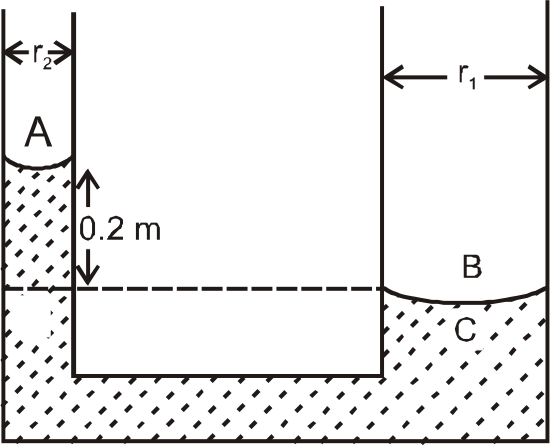The limbs of a manometer consist of uniform capillary tubes of radii 1.4×10−3m and 7.2×10−4m. Find out the correct pressure difference if the level of the liquid (density 103kg/m3, surface tension 72×10−3 N/m) in narrower tube stands 0.2m above that in the broader tube.
If p1 and p2 are the pressures in the broader and narrower tubes of radii r1 and r2 respectively, the pressure just below the meniscus in the respective tubes will be
p1−2Tr1 and p2−2Tr2
So that [p1−2Tr1]−[p2−2Tr2]=hρg
or p1−p2=hρg−2T[1r2−1r1]

Assuming the angle of contact to be zero . i.e., radius of meniscus equal to that of capillary,
p1−p2=0.2×103×9.8−2×72×10−3[17.2×10−4−114×10−4]
or p1−p2=1960−97=1863Pa
Similar Questions
The limbs of a manometer consist of uniform capillary tubes of radii are 10−3&7.2×10−4m find out the correct pressure difference if the level of the liquid in narrower tube stands 0.2 m above that in the broader tube. (density of liquid =103kg/m3, surface tension =72×10−3N/m)
View SolutionThe limbs of a manometer consists of uniform capillary tubes of radii 1.44×10−3m and 7.2×104m. If the level of the liquid in the narrower tube stands 0.2 m above that in the broader tube, pressure difference between A and B is found to be 310λN/m2. Here λ is an integer. Find λ (density = 103kg/m3, surface tension = 72×10−3N/m). (take g=9.8m/s2)

View Solution
Knowledge Check
A capillary tube of radius r can support a liquid of weight 6.28×10−4N. If the surface tension of the liquid is 5×10−2N/m. The radius of capillary must be
A2×10−3mB2×10−4mC1.5×10−3D12.5×10−4m
The limbs of a manometer consists of uniform capillary tubes of radii 1.44×10−3m and 7.2×104m. If the level of the liquid in the narrower tube stands 0.2 m above that in the broader tube, pressure difference between A and B is found to be 310λN/m2. Here λ is an integer. Find λ (density = 103kg/m3, surface tension = 72×10−3N/m). (take g=9.8m/s2)

View SolutionA barometer contains two uniform capillaries of radii 1.4×10−3m and 7.2×10−4m. If the height of liquid in narrow tube is 0.2m more than that in wide tube, calculate the true pressure difference. Density of liquid =103kg/m3, surface tension =72×10−3N/m and g=9.8ms−12.
View SolutionA barometer contains two uniform capillaries of radii 1.4×10−3m and 7.2×10−4m. If the height of liquid in narrow tube is 0.2m more than that in wide tube, calculate the true pressure difference. Density of liqid =103kg/m3, surface tension =72×10−3N/m and g=9.8ms−12.
View SolutionA barometer contains two uniform capillries of radii 1.44×10−3m and 7.2×10−4m. If the height of the liquid in the narrow tube is 0.2m more than that in the wide tube, calculate the true pressure difference. Density of liquid =103kg/m3, surface tension =72×10−3N/m and g=m/s2.
View SolutionA barometer contains two uniform capillries of radii 1.44×10−3m and 7.2×10−4m. If the height of the liquid in the narrow tube is 0.2m more than that in the wide tube, calculate the true pressure difference. Density of liquid =103kg/m3, surface tension =72×10−3N/m and g=m/s2.
View SolutionA capillary tube of radius 0.03 mm is held vertically in a liquid of density 0.85×103 kg/m3 and surface tension 4×10−2 N/m. The angle of contact of liquid -glass is given by cosθ=0.5 then rise of liquid in the capillary tube is.?
View SolutionMercury in a capillary tube suffers a depression of 13.2 mm. Find the diameter of the tube. If angle of contact of mercury is 140∘ and density 13.6×103kgm−3 Surface tension of mercury is 540×10−3Nm−1
View Solution
